Family : Pongidae

Text © Dr. Gianni Olivo

English translation by Mario Beltramini
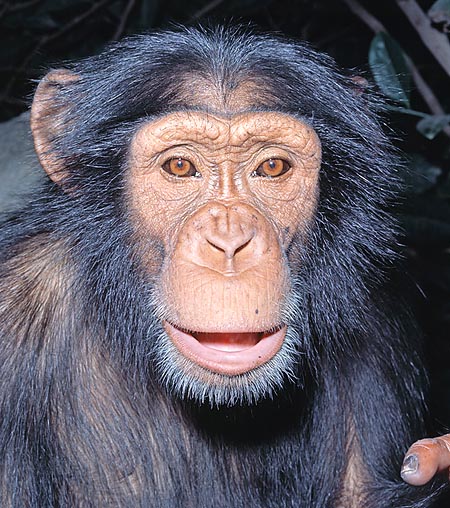
In cinema the chimp is a gentle and meek animal © Giuseppe Mazza
Let us even say that the two primates compete on an equal footing for the … primacy, as, to render them known also to those who never did take any interest in animals, have provided communications mass media, such as the novels, the movies and, later on, the television.
Yet, the reputation of the two animals was based, as it often happens, on a sort of humanization of the same, thing which, if on a side can be useful for introducing some species to the general public, by having them as heroes in followed and appreciated episodes, on the other hand is often parent of a certain misinformation which generates wrong, inaccurate and, at times, even dangerous, convictions and beliefs. I took the liberty to do this premise, which might look as wandered from the subject, because, as is the case for the gorilla, but in this case in even a greater extent, the idea many have about certain animal species clashes, at times, with the reality of the facts and, for own experience, when you talk about certain issues of the animal life, there are those watching at you as if you were a blasphemer uttering a heresy worthy of the stake.
The “personality” attributed to the two primates who mostly seem to resemble us is quite different and, at times, misleading: the gorilla is, in the collective imagination, the expression of the brute force (not often in a benevolent key, not for nothing they have coined the term of “gorilla” referred to a human stereotype), at times possibly associated with the idea of background of goodness enclosed in the body of a destructive giant, so that it has appeared, from time to time, as the much dreaded King Kong to whom the tribe of the mysterious island offered human sacrifices, to then falling in love of the woman expected to become its victim, or as the good giant but however always capable to make disasters and to kill, whilst the chimpanzee, on the contrary, has almost always had, in the literature and in the movies, the image of a being not only intelligent and similar to us, but kind and docile.
Its smaller size and the greater facility in getting specimens and train them have meant that it also performed in the circuses, beloved by the children, travelled in the space and disappeared along with Tarzan n comic and movies, but did never appear in the guise of a potential foe like that sort of an ogre, his distant cousin. And also this is, after me, an error, as we shall see later and an error which may reveal quite dangerous.
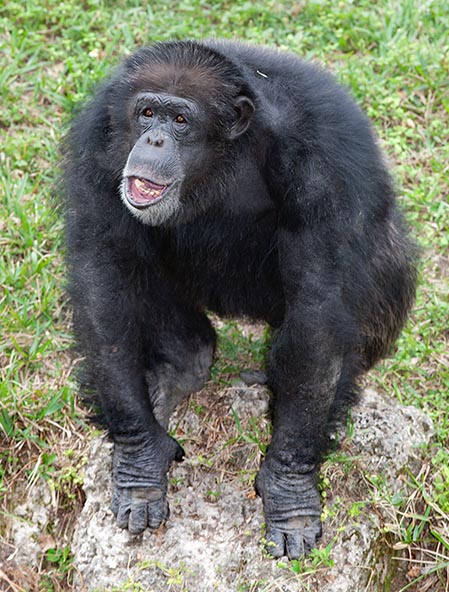
Actually, Pan troglodytes is often aggressive and dangerous © Giuseppe Mazza
When erect, it reaches the 170 cm (males) and the weight, in the wild, is of about 30 kg for the female and of 50-60 kg in the males, whilst individuals in captivity may “put on weight”, thus reaching the quintal.
The firs scientific name of “Pan” refers to its look of … satyr of the woods and refers to the god Pan, whilst the second term, “troglodytes”, is perhaps less accurate, although suggestive, as it is not a …cavernicolous animal, but, maybe, the look of “cave-dweller”, and the idea of an ancient ancestor of ours, akin to him, have played there role in the etymology, who knows.
Even if less robust and less massive than the gorilla, with shorter arms, which get just under the knee, when standing, it is, however, endowed of a remarkable strength and much greater than that of the man.
The hands have long fingers, whilst the thumb, opposable, is shorter; the feet are highly prehensile, with opposable “big thumb”.
The head is rounded, without the quite evident crest typical of the gorilla, the face and the ears are bare, without any cover of hairs, the nose is small, with little nostrils too, the upper lip is long and very mobile. The dental apparatus is more robust than that of the man and the canines, particularly in the males, are developed and form dangerous weapons, seen also the strength of the masticatory muscles, capable to give devastating bites.
Rightly, an interesting particular is the “face”, which differs from individual to individual, facilitating the recognition and allowing, at times, discerning the familiarity of an individual. The hair is often black, but may vary from the cinnamon to the chestnut brown, whilst the thickness and the density of the hair vary depending on the habitat and, when ageing, often do appear areas of … alopecia and hairs with paler or white colour, which confer an almost salt and pepper look.
The habitat varies from the savannah, provided with trees, to the pluvial forest and the geographic distribution spreads from Sierra Leone and Guinea up to Uganda and Tanzania.
The Congo River, as it happens for various species, seems to form a sort of insurmountable barrier, separating two areas where not only the fauna, but also the flora look different, and the chimpanzee is found only north of the great river.
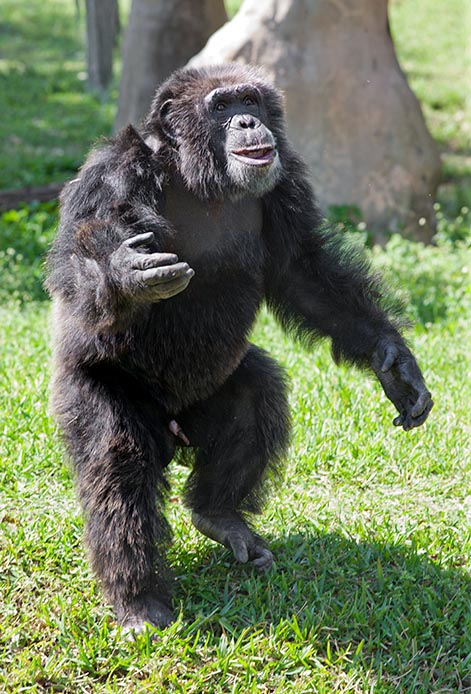
But as its name states, it may seem a dancing satyr © Giuseppe Mazza
Animal equally adapted to the arboreal life as well as to that on the ground, it mostly nourishes on the plants but goes hunting mainly on the soil, because part of its alimentation comes, as we shall see, from the animal kingdom.
Even if it is present in the savannah and in the forest, the second habitat hosts most of the populations, resulting as the most suitable for the species.
Wile talking about the alimentary habits of the chimpanzee, I would like to mention a perhaps little known matter and by sure not much appreciated to someone, but undeniable and which it is necessary to know in order to have an idea not only of the diet of this ape but also of certain behaviours which render it closer, at times, to some cynocephals (baboon) than to the gorilla.
The gorilla may prove dangerous in some circumstances (see text Gorilla gorilla), and this is known and accepted by all, but it is, indeed, an animal that, even if capable to be much aggressive towards a potential threat and also towards its own conspecifics (infants and females included), it nourishes exclusively of vegetables and does not attack the man if not menaced or if thinking that its harem is under threat, whilst the chimpanzee, even if mainly frugivorous or however mostly eating aliments of vegetal origin, is omnivorous and spends about the 5% of its dedicated time to nourish in the research and seize of animal proteins.
For what the “hunting” is concerned, the behaviours seem to vary also depending on the geographic zone, in the sense that in some areas the preferences go to certain sources of proteins, in others, they vary completely.
To offer some examples, in the Gombe (Congo) zone, the chimpanzee prefer the termites, whilst in Gabon they ignore them completely and engage themselves with enthusiasm to ravage the safari ants, ants of the genus Dorylus, which, in the periods when the food resources are poor, move in columns including up to 50 million of individuals, attacking any being they meet during their march: the mandibles of the soldiers are so much strong that their bite not only causes bleeding, but they are utilized as suture for sewing the wounds. However, the preys of the chimpanzees include a broad range of animals; from the insects to the nidicolous, eggs, reptilians and also mammals, up to the size of young antelopes, potamochoeri and rodents.
The chimpanzee, therefore, is an omnivorous opportunist, a runner of the forest which takes advantage from its fruits as well as from many of its inhabitants. And amongst the preys, even if occasional, stands also the man.
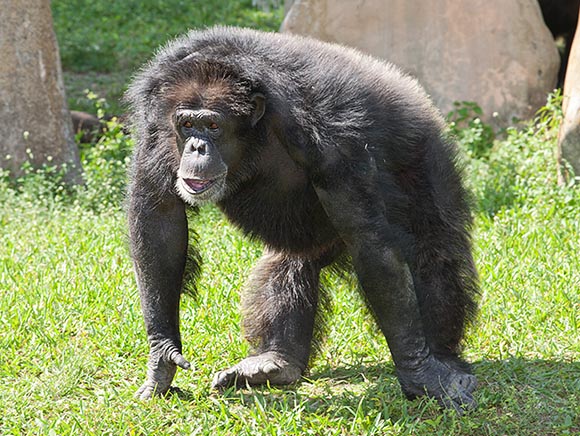
Surely, chimp is an omnivorous opportunist well adapted to various habitats © Giuseppe Mazza
Just only in Uganda were reported, I few years, 15 attacks against children, of which about a half were fatal, whilst the survivors underwent terrible wounds and mutilations. One of these chimpanzee killers, in particular, nicknamed Saddam, terrorized a village close to Kibale National Park, kidnapping and slaughtering at least three kids before being killed.
Another chimpanzee, nicknamed Frodo, killed the daughter of a ranger of Gombe National Park, in Tanzania, in 2002.
The mortal danger represented by these apes is known, and in fact the rules of the Park forbid the entrance to children less than 12 years old, and the mother of the young victim did know this well, being the wife of a ranger, but thought that the presence of two adults should be a sufficient deterrent.
The kid was on the shoulders of the niece who was following the mother: Frodo, an about 50 kg animal, caught her suddenly and climbed a tree where it began eating her.
Usually, the big game hunting is effected by groups of males specialized in such activity, and one of the preferred preys is represented by colobus monkeys (Procolobus), but also by duikers (Cefalofi) and other antelopes are seized and eaten and the individual killing the prey usually has the right to “serve” the first, whilst the other members of the group of hunters at times stretch out their hands almost in a ritual demand from their end, to which they will be entitled after having respected the propriety of the … chief hunter.
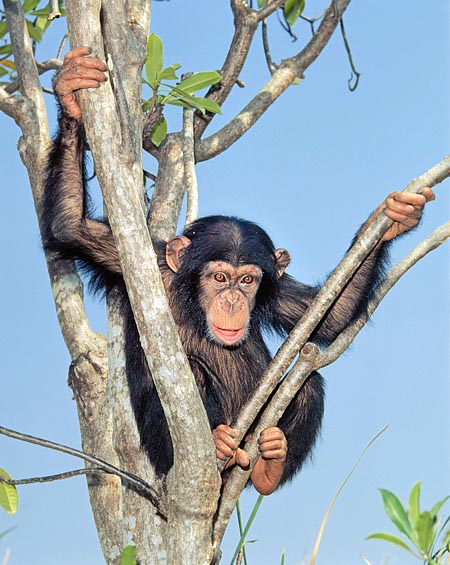
In fact is at ease on the soil and on trees too © Giuseppe Mazza
The social organization stands in groups including more males, with territorial habits, and where only the females migrate, but these communities are quite different from those of the gorillas or of other monkeys: the chimpanzees, in fact, do not form compact and well bonded groups; their “tribes”, which may include from 10 to more than 100 members, share the same area but rarely associate strictly in one only group, behaving somewhat like the brown hyena, animal that, even if living in “community” is usually met alone.
The activities of food research or the various …chimpanzee duties see individuals alone or united in bands of various consistencies, but without fixed rules: at times, we see family groups including only one female with her infants, other times, groups of 50-70 individuals together, but, usually, the males tend to go around alone or in group, but without females with them.
Equally at home on the soil or on the plants, they usually spend the night on the trees, where they build up a “nest” which, depending on the habitat conditions, may be at a height of three meters as well as at 30, even if, in the pluvial forest, the only dangers to which they are exposed are represented by the leopard (also if the forest leopards, as an average, tend to be smaller), by the man and, mainly, by other groups chimpanzee males.
Indeed, in some zones of savannah, hyena and lion may be a more important risk, but however, a chimpanzee, especially if male, is always a formidable opponent: three time stronger than an adult human, endowed of four hands and of a fearful teeth apparatus, can give its own stuff to many predators or at least sell its life very dearly. The “territory” of a community may vary from less than 4 square km in the pluvial forest, where the abundance of food is concentrated in modest areas, up to 50 square km, in savannah, sometimes with actual migrations, so as to extend their action range up to 400 square km, as it has been observed in Senegal.
Due to the fluidity of the social ties and the remarkable longevity (40-60 years), it is not simple to fully understand the complexity of the social life of these monkeys, and in particular the relations between females still present little known sides, but, for what the reproductive activity is concerned, it has been ascertained the female has a “menstrual cycle” of 34 days, with regular bleeding, which manifests the first time (menarche) by around the 9 or 10 years of age.
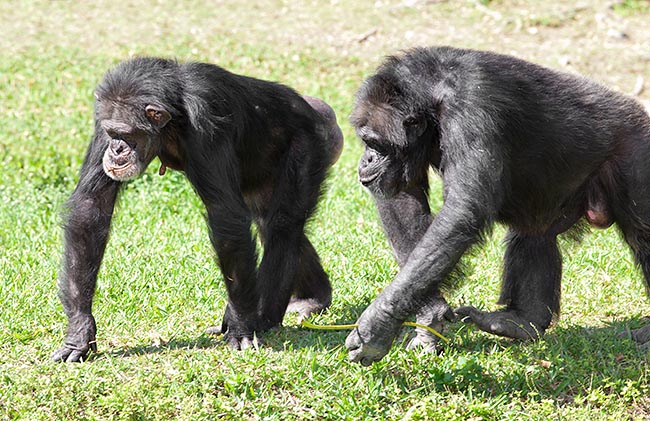
Each male has own seduction method. Here it gives the female a sprig to chew © Giuseppe Mazza
Even if the …menarche appears when 9-10 years old, for at least the two flowing years the female is virtually sterile and can mate light-heartedly without procreating, as if taking the pill, almost a sort of test period established by the nature before reaching the maternity, whereby, it may reproduce, as an average, only by the 12 years of age.
The males are much more precocious: they theoretically mate already when three years old, but only by the 3 or 4 years they acquire the capacity of “courting” the female.
In fact, the ritual of the courtship consist more in an exhibition of aggressiveness towards the female than in an actual “courting” and each male may show characteristics differing from the others in its …technique of seduction. The mating happens usually like in most mammals from behind and rarely is utilized the poison, let’s say, of the missionary, as it often happens, on the contrary, in the case of the bonobo: the female couples, as an average, 5 or 6 times per day, during the first week of oestrus, and she is much …uninhibited, willingly accepting the attention of whatever male is within range, whilst the males, on their hand, reveal being rather sporting, avoiding to interfere with the lover of the moment, clearly, jealousy is not contemplated into the chimpanzee etiquette, unlike that of man.
The gestation lasts 8 months and the young, for the first six months, depends totally from the mother. Sometimes it has been observed a sort of adoption of a young who has become an orphan by a female of the same familiar group of the mother, but this is not necessarily the rule and the infant mortality is not indifferent. The contacts between the members of the group are maintained by means of a vast range of sound, visual and tactile signals.
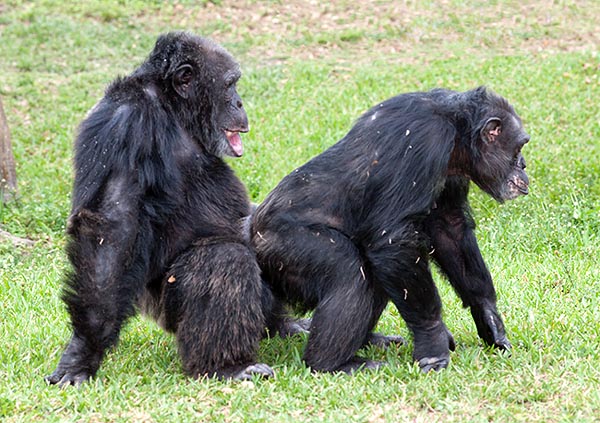
Immediate reward. Females are uninhibited and males not jealous © Giuseppe Mazza
When close by sure the expressions of the “face” play a substantial role, seen the expressivity and the mobility of mouth, eyes and ears, but also the gesturality of the limbs is important as well as the vocalizations.
Unlike the other monkeys, even the apes, however, there are no typical “cries” of a sex or of a class of age and each single individual masters the whole vocal repertoire of the species.
A typical sound is the Hoo-hoo-hoo pant known by all, mainly utilized for “marking” the territory, but besides this, there are also other sounds: a barking similar to that of the Bushbuck (Tralegaphus scriptus), grunts, a sort of short roar, shrieks of various tonalities, among which, a much modulated Haaaaaa, going from the bleat to the growl. The aggressiveness is shown with a series of postures going from the simple intimidation to the determined charge (especially against males of other clans who have, in case, invaded their territory).
A determined and not demonstrative charge takes place, as it happens for the elephant, usually silently, running on all fours, at full speed, and concludes with a determined aggression which may cause the death of the opponent or of the aggressor or may cause more or serious wounds.
Concluding, therefore, the chimpanzee is an animal having a much complex personality and behaviour and, in spite being the maybe most studied monkey in absolute, we are far away to be able to claim that we know it thoroughly, especially, then for what its secret life in the natural habitat is concerned, formed, among other things, by the pluvial forest, one of the habitats which, still now, reserve continuous surprises and which is well far away of having been fully “explored”.
→ For general notions about Primates please click here.
→ To appreciate the biodiversity within the PRIMATES please click here.
